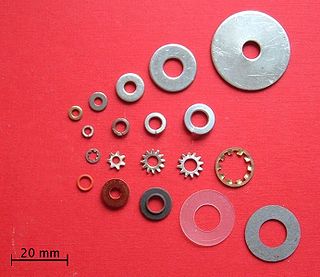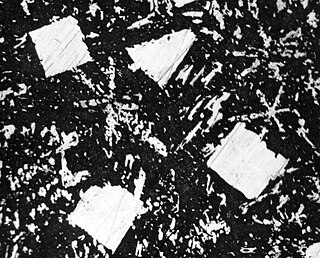
Friction is the force resisting the relative motion of solid surfaces, fluid layers, and material elements sliding against each other. There are several types of friction:

A ball bearing is a type of rolling-element bearing that uses balls to maintain the separation between the bearing races.
Fluid bearings are bearings in which the load is supported by a thin layer of rapidly moving pressurized liquid or gas between the bearing surfaces. Since there is no contact between the moving parts, there is no sliding friction, allowing fluid bearings to have lower friction, wear and vibration than many other types of bearings.

Lubrication is the process or technique of using a lubricant to reduce friction and/or wear in a contact between two surfaces. The study of lubrication is a discipline in the field of tribology.

A plain bearing, or more commonly sliding bearing and slide bearing, is the simplest type of bearing, comprising just a bearing surface and no rolling elements. Therefore, the journal slides over the bearing surface. The simplest example of a plain bearing is a shaft rotating in a hole. A simple linear bearing can be a pair of flat surfaces designed to allow motion; e.g., a drawer and the slides it rests on or the ways on the bed of a lathe.

A rolling-element bearing, also known as a rolling bearing, is a bearing which carries a load by placing rolling elements between two bearing rings called races. The relative motion of the races causes the rolling elements to roll with very little rolling resistance and with little sliding.

A washer is a thin plate with a hole that is normally used to distribute the load of a threaded fastener, such as a bolt or nut. Other uses are as a spacer, spring, wear pad, preload indicating device, locking device, and to reduce vibration. Washers often have an outer diameter (OD) about twice their inner diameter (ID), but this can vary quite widely.

Bolted joints are one of the most common elements in construction and machine design. They consist of fasteners that capture and join other parts, and are secured with the mating of screw threads.

Babbitt, also called Babbitt metal or bearing metal, is any of several alloys used for the bearing surface in a plain bearing.
Grease is a semisolid lubricant. Grease generally consists of a soap emulsified with mineral or vegetable oil. The characteristic feature of greases is that they possess a high initial viscosity, which upon the application of shear, drops to give the effect of an oil-lubricated bearing of approximately the same viscosity as the base oil used in the grease. This change in viscosity is called shear thinning. Grease is sometimes used to describe lubricating materials that are simply soft solids or high viscosity liquids, but these materials do not exhibit the shear-thinning properties characteristic of the classical grease. For example, petroleum jellies such as Vaseline are not generally classified as greases.
A linear-motion bearing or linear slide is a bearing designed to provide free motion in one direction. There are many different types of linear motion bearings.
Oil additives are chemical compounds that improve the lubricant performance of base oil. The manufacturer of many different oils can utilize the same base stock for each formulation and can choose different additives for each specific application. Additives comprise up to 5% by weight of some oils.
The Stribeck Curve is a fundamental concept in the field of tribology. It shows that friction in fluid-lubricated contacts is a non-linear function of the contact load, the lubricant viscosity and the lubricant entrainment speed. The discovery and underlying research is usually attributed to Richard Stribeck and Mayo D. Hersey, who studied friction in journal bearings for railway wagon applications during the first half of the 20th century; however, other researchers have arrived at similar conclusions before.
Dry lubricants or solid lubricants are materials that, despite being in the solid phase, are able to reduce friction between two surfaces sliding against each other without the need for a liquid oil medium.
Rulon is the trade name for a family of PTFE plastics produced by Saint-Gobain Performance Plastics. Rulon plastics are known for their low coefficient of friction, excellent abrasion resistance, wide range of operating temperatures, and chemical inertness. Common applications for Rulon include seals, piston rings, bearings, and electrical insulation.

Air bearings are bearings that use a thin film of pressurized gas to provide a low friction load-bearing interface between surfaces. The two surfaces do not touch, thus avoiding the traditional bearing-related problems of friction, wear, particulates, and lubricant handling, and offer distinct advantages in precision positioning, such as lacking backlash and static friction, as well as in high-speed applications.
A composite bearing is used to maintain separation and control friction between two moving parts. The distinguishing characteristic of a composite bearing is that the bearing is made from a combination of materials such as a resin reinforced with fibre and this may also include friction reducing lubricants and ingredients. A composite bearing is not simply a PTFE bearing in a carrier of another material, this is a PTFE bearing in a carrier. The plain composite bearing can be lighter than a rolling element bearing but this is not always a feature as some composites are extremely dense which results in lower porosity. Another distinctive feature of the composite bearing is its lightweight design - it can be one-tenth the weight of the traditional rolling element bearing. No heavy metals are used in its manufacture.












